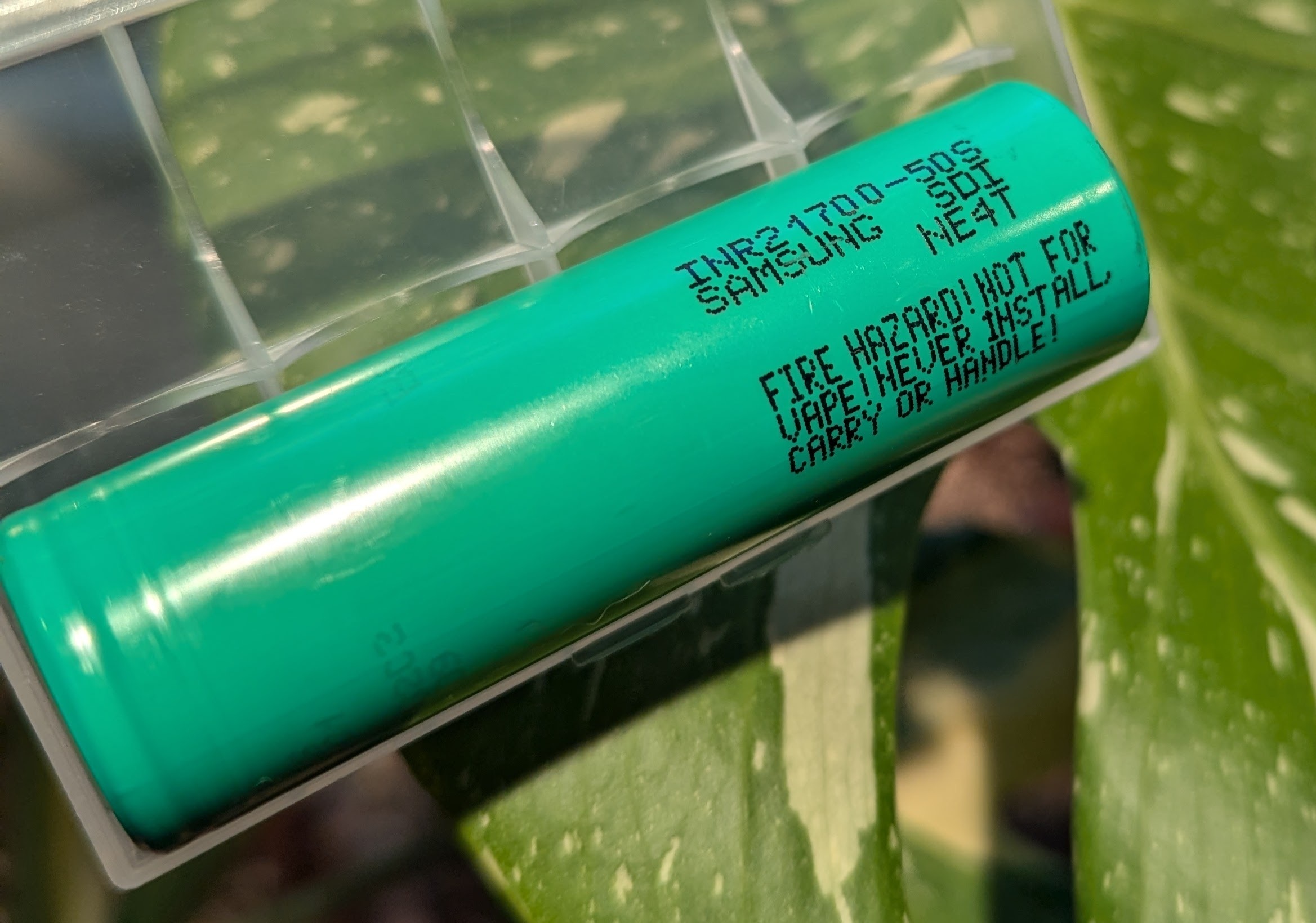600 miles? Call me when they make one small enough to fit in a car
heyooooo
If it were any other company I would be thrilled. With Samsung, this is going to be internet enabled, you’ll need an app to turn your car on and off, and it’ll probably play ads at high volumes constantly while driving.
I know you jest, but Samsung is a massive battery supplier.
These will be plain old dumb batteries
I dunno man, my 21700 cells just got an OTA update and now my flashlights wont turn on without watching an ad blinked out in mores code first.

Don’t you know it’s popular to shit on Samsung…or something?
Its a battery that’ll be used by other manufacturers
One could hope that the designs get leaked and the tech becomes widely available without the corporate shitbags.
I am 100% certain that Samsung is currently in litigation regarding exactly this kind of thing at this very moment. These companies have massive arms for corporate espionage and the like, and because of patent laws, it’s always worth spending time and money protecting your tech.
Wait, which company had their battery blowing up ? And were not safe for flight. If these battery blew up then it would be devastating.
…then it will catch fire.
…and will probably explode.
Are solid state batteries having issues with catching fire? I thought that was liquid batteries? Or is this just like saying everything bad that ever happened with lithium ion batteries will happen with everything else?
It was just a joke, ffs.
Samsung devices & appliances are notoriously prone to catastrophic failure - as a matter of fact, I actually had a Samsung TV melt itself - which turns out is a common issue (Google “Samsung tv melting corner”).
Then there’s the Samsung battery fire issues, Samsung refrigerator safety lawsuits, etc.
And the washing machines that keep grenading and killing people.
To be fair, they don’t actually grenade.
…They turn into life sized, several-hundred-pound Beyblades ricocheting around your house. Which isn’t actually any better.
I have an 12? year old Samsung LED TV. It’s good. Getting rid of it while it’s still working is such a waste.
Keep a fire extinguisher nearby! ;-)
This
deleted by creator
FTA:
Apparently, they are also rather expensive to produce, since it warns that they will first go into the “super premium” EV segment of luxury electric cars that can cover more than 600 miles on a charge.
So yes. Expensive initially.

Remember the Note 7 recalls?
https://www.gta5-mods.com/weapons/samsung-galaxy-note-7-bomb
The whole point of a solid state battery is that they don’t do that.
I’d love to imagine around 20 years later people would be retrofitting old and heavy phone, laptop, and EV batteries with lighter and faster-charging ones…
What material is inside?
These articles call it “oxide” but what exactly is it?
Things which oxidized.
Seriously I hate articles like this.
Unfortunately the source does not seem to indicate what Samsung is using.
https://www.thelec.kr/news/articleView.html?idxno=29222
It does say that LG will be producing a sulfide based electrolyte.
the source does not seem to indicate
LOL that’s why I wrote my question, smartie.
Also, what is a “solid state” battery anyway? A capacitor?
it’s still a Li-ion (like most current rechargeables) but the electrolyte - the medium that transfers the ions from the anode to the cathode - (the + and -) inside the battery is made of a solid material instead of the current gen liquid ones. The benefits are less weight/size (as liquids take up more space than solids) and a more stable composition - the liquid electrolyte can’t leak - the way batteries get gunky and corroded if left for a while
And if I understand correctly, they are safer because there is less chance of parts touching inside. I don’t know the correct t terminology, but one of the big problems with current li-ion batteries is that if they get physically damaged, parts inside can touch, which basically starts a short/chain reaction that turns into a dangerous thermal runaway.
Also if I remember correctly the guy that invented li-ion invented some kind of solid state battery with glass right before he died. I’m assuming this technology stems from that.
Please correct me if I’m wrong on any of this. Knowledge is power.
At first I thought, damn a 600 mile battery. That’s a big battery.
Thankfully solid state batteries save 30-50% weight compared to current ones so batteries can be a bit smaller than they otherwise would be. This one will likely be 150 kWh.
Wait, are EV batteries even replaceable?
Not this one. It’s 600 miles long
I like this comment, because Samsung in other areas does indeed get confused about batteries being consumable.
Like their shitty phones. Even the bootloader tyrant huawei has pull-tabs. And of course their phone with the self-destruct feature.
Yes
TL;DR: Depends on what you mean.
Long version:
Disclaimer: I’m not an expert by any means, I haven’t vetted the links properly (or at all), they’re mostly there for illustration and if you want to read further. Also, the last time I actually read up on this is quite some years ago, so stuff may have changed in the industry and/or my memory on specifics is foggy. Many of the links lead to Tesla sources since I first looked into this topic back before Musk made it known to the public that he’s an insufferable human being.
Batteries are usually structurally integrated into the chassis with modern EVs, since that means space (and often small weight) savings, and is easier/faster to do in manufacturing.
With that knowledge, it is safe to assume that replacing a car’s battery is a difficult or next to impossible task, outside of end-of-life reuse.
But this is actually where it gets interesting, since EV batteries last many years anyways: What happens when the car’s time has come?
Well… the batteries can be reused. It’s not a trivial process, there’s several ways to do it, but the best intuitive explanation I’ve found is this: In raw ore, lithium and other metals are present at maybe 0.1 or 1%, per tonne of material. In batteries, it’s maybe 99% of reusable, expensive material. Even if you let it be 90 due to inefficiencies in recovery, or whatever, it’ll still make way more sense financially to work with old batteries – once you have the process figured out and automated machinery to get it done in place.
All that is assuming total destruction of the existing cells, which, depending on their state, may not even be necessary at all. In fact, it looks like all of that may not be needed for as much as >80% of batteries. Wow!
And we all know the best way to ensure companies are doing something is if the financial aspect aligns with their goals. It’s in their best self-interest to be able to and actually do this.
So: Replaceability per car – eh, doesn’t look to great. Replaceability across the industry? Perfect.
Needs to be an option to put these into todays EVs. You shouldn’t have to buy a brand new car to get better battery technology.
Aaaaaaand (deep breath)
Bullshit
Great, now car manufacturers need to figure out how they can make it stop holding charge at 10years.
I mean, the headline does say 20 years soooo…
Also, Teslas are approaching 10 years old and as far as I know their batteries are still going strong (yes, I know their quality control is otherwise sketchy). The Nissan Leaf batteries are getting pretty sketchy, but they don’t have any battery conditioning - just air-cooled. That’s not doing longevity any favors. All other major EVs have battery management systems and seem to be holding up ok. They’re also generally warranted for 8 years. I don’t think they’d only have a 2-year buffer between warranty and expected life.
Hope they arent lipo. Have had two of those balloon up on me so far and wouldnt want one to set my car on fire from thermal runaway
solid-state battery
They can’t do what you describe.
Solid state has zero possibility of doing either of those. That is one of the big selling points. The others are that they are 30-50% get, they last longer, and they can charge faster.
from what i understand, most vehicles use LiFe (i think this was wrong actually, i think most modern EVs use li-ion batts, they really should be using LiFe though.) battery technology, which is almost innert compared to LiPo technology, phones use Li ion batteries which are different from both of those.
Lithium batt technology sucks.
Both my samsung phones as well as all the lgs ive had used lipo batteries. Both lgs and one samsung (so far) have swollen enough to push the display out of the bezel.
please inform me whether those batts said “li-ion” on them, or “LiPo” on them, because those are different.
Most modern phones, to my knowledge, use li-ion batts.
LiPo has sort of become a catch all for lithium batts, but it’s not accurate.
They were all non removable so nothing to see but the swollen cases.
they were probably li-ion batteries then.
Technically LiPo is a subset of li-ion, but it’s still a subset, so.









